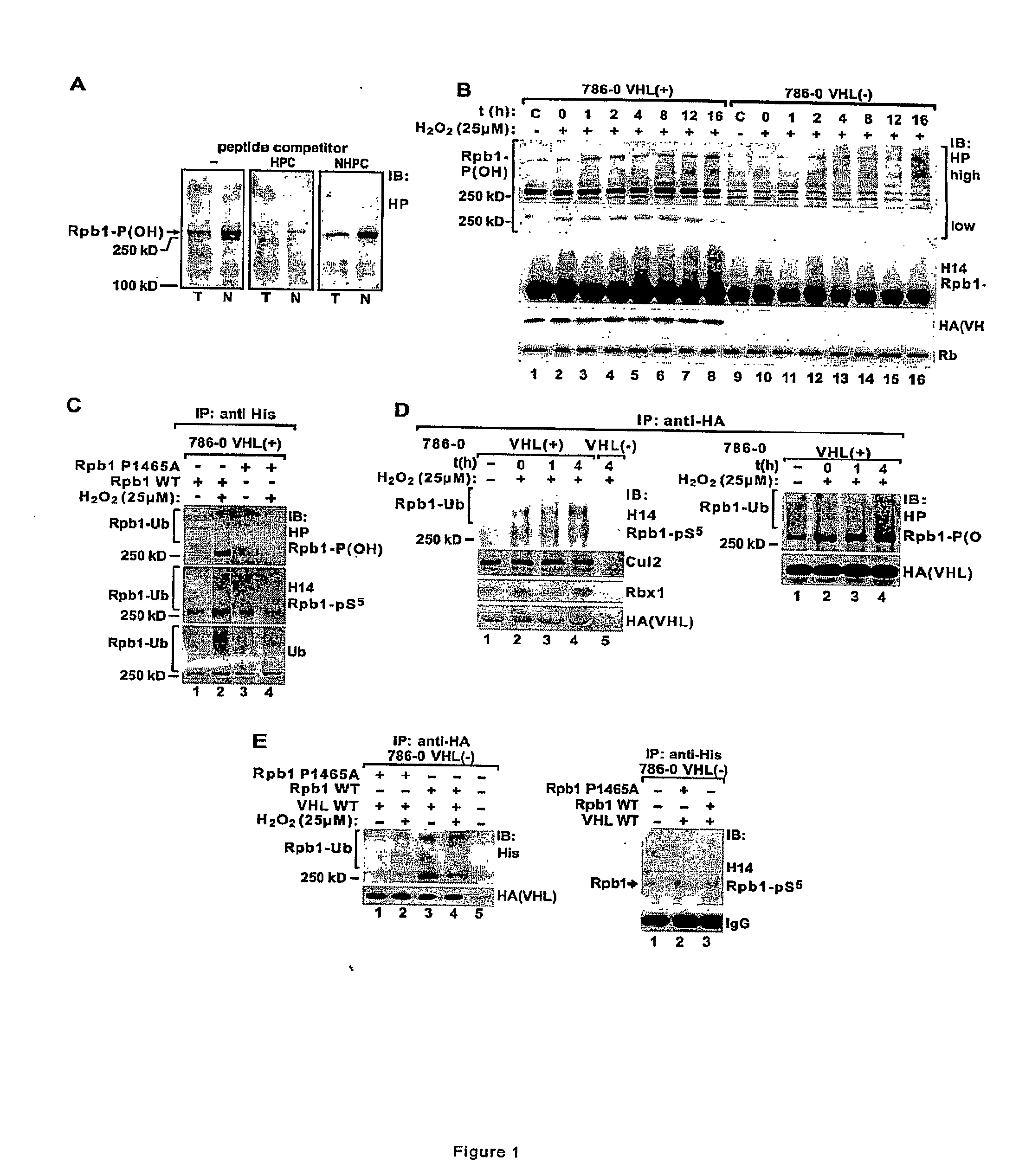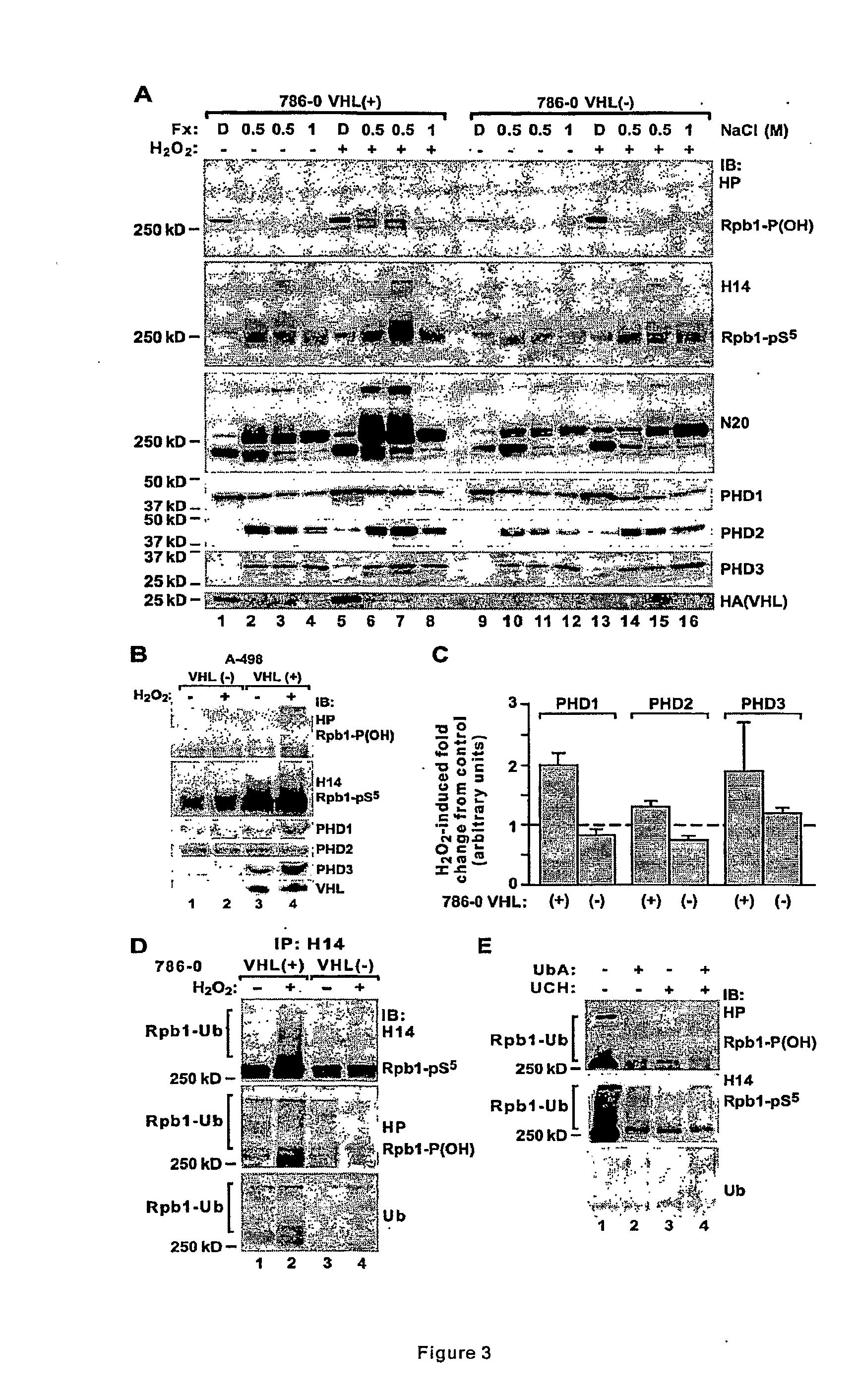Methods for diagnosing and treating cancers via manipulations of a...pathway
a cancer and pathway technology, applied in the field of cancer diagnosis and treatment via pathway manipulation, can solve the problems of only about 18% survival rate and asymptomatic kidney cancer, and achieve the effects of increasing the risk of cancer development, and promoting hydroxylation of rpb1
- Summary
- Abstract
- Description
- Claims
- Application Information
AI Technical Summary
Benefits of technology
Problems solved by technology
Method used
Image
Examples
example 1
[0043]This Example illustrates the use of novel antibody to investigate P1465 hydroxylation and Rpb1 ubiquitylation. The antibody HP was developed against an Rpb1 peptide containing hydroxylated proline P1465 (FIG. 1A). The antibody was used to investigate the role of oxidative stress in P1465 hydroxylation and pVHL-dependent ubiquitylation of Rpb1. HP detects a major band at approximately 250 kD, which is highly enriched in the nuclear fraction as compared to total cellular extracts (FIG. 1A). The experiments were performed using RCC 786-0 cells, a well-characterized model of renal cell cancer, in which native pVHL is absent or stably reconstituted (in legend: 786-0 VHL(−) and VHL(+)). The cells were exposed briefly to a low concentration of H2O2 (25 μM, 15 min) to induce a generic oxidative stress, and assayed at the indicated time points after treatment.
[0044]It was found that a 15 min treatment with H2O2 induced persistent (lasting several hours) pVHL-dependent hydroxylation of ...
example 2
[0049]This example demonstrates that hydroxylation and ubiquitylation occur on Ser-5 phosphorylated Rpb1.
[0050]Immunoprecipitation of the transfected histidine tagged wild type or P1465A mutant Rpb1 using anti-histidine antibody demonstrated that H2O2 induced hydroxylation and ubiquitylation and Ser-5 phosphorylation of WT, but not P1465A mutant Rpb1 cells (FIG. 1C). The Rpb1 P1465A mutant showed some constitutive ubiquitylation that was not regulated by H2O2 (FIG. 1C, lanes 3 & 4).
[0051]Rpb1 was immunoprecipitated using H14 antibody from the second 0.5 M chromatin fraction, and the immunoprecipitated Rpb1 was immunobloted with BP and anti-ubiquitin antibodies (FIG. 3D). Clearly, the Rpb1 hyperphosphorylated on Ser-5 is also hydroxylated and ubiquitylated in response to oxidative stress and this response depends on the presence of functional pVHL (FIG. 1C). To confirm ubiquitylation of the hydroxylated and hyperphosphorylated Rpb1, the extracts from the second 0.5 M chromatin fracti...
example 3
[0052]This example demonstrates that hydroxylation of Rpb1 on P1465 occurs through activity of HIF-prolyl-4-hydroxylases and requires presence of pVHL. It also demonstrates that Ser-5 phosphorylation is dependent on hydroxylation of Rpb1 and the presence of pVHL.
[0053]Because of the similarity in the Rpb1 motif containing P1465 with an analogous motif on HIF-α, it was hypothesized that one or more of HIF prolyl hydroxylases hydroxylates Rpb1. PHDs represent a relatively novel family of deoxygenases utilizing Fe(II), ketoglutarate, molecular O2 and ascorbate as cofactors, and were first identified as proline hydroxylases for HIF-αs (60). We discovered a presence and strict correlation of the levels of all three PHDs with the levels of Rpb1 hydroxylated in response to oxidative stress in the crude chromatin fractions of both 786-0 and A-498 cell lines expressing wild type pVHL, but not in those cells with non-functional pVHL (FIGS. 3A, 3B and 3C). The fractions of chromatin extract co...
PUM
| Property | Measurement | Unit |
|---|---|---|
| Pressure | aaaaa | aaaaa |
| Stress optical coefficient | aaaaa | aaaaa |
| Distribution | aaaaa | aaaaa |
Abstract
Description
Claims
Application Information
 Login to View More
Login to View More - R&D
- Intellectual Property
- Life Sciences
- Materials
- Tech Scout
- Unparalleled Data Quality
- Higher Quality Content
- 60% Fewer Hallucinations
Browse by: Latest US Patents, China's latest patents, Technical Efficacy Thesaurus, Application Domain, Technology Topic, Popular Technical Reports.
© 2025 PatSnap. All rights reserved.Legal|Privacy policy|Modern Slavery Act Transparency Statement|Sitemap|About US| Contact US: help@patsnap.com



